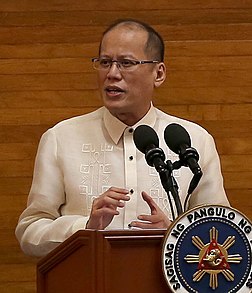
Benigno Simeon Cojuangco Aquino III, also known as "PNoy" or "Noynoy", is a Filipino politician who served as the 15th president of the Philippines from 2010 until 2016. Aquino is a fourth-generation politician and was the chairman of the Liberal Party from 2010 to 2016.

The vice president of the Philippines is the second-highest executive official of the government of the Philippines, after the president. The vice president currently holds office at the Quezon City Reception House in Quezon City. Previously, the vice president of the Philippines held office at the Coconut Palace, the Philippine National Bank Financial Center, and the Philippine International Convention Center, all in Pasay, Metro Manila.

The Department of Transportation is the executive department of the Philippine government responsible for the maintenance and expansion of viable, efficient, and dependable transportation systems as effective instruments for national recovery and economic progress. It is responsible for the country's land, air, and sea communications infrastructure.

The Philippine Postal Corporation, abbreviated as Post Office, is a government-owned and controlled corporation responsible for providing postal services in the Philippines. The Philippine Postal Corporation has in excess of 8,000 employees and runs more than 1,355 post offices nationwide. The Philippine Post Office is based in the Philippines' primary post office, and is currently headed by Postmaster General and CEO Mr. Norman "Postman" N. Fulgencio. The historic Manila Central Post Office is situated at the Plaza Liwasang Bonifacio and overlooks the Pasig River. Its policy-making body is the board of directors, headed by its chairman, Mr. Raul R. Bendigo. The board of directors is composed of seven members, including the postmaster general, who serves simultaneously as the chief executive officer.
Ninoy Aquino Day is a national non-working holiday in the Philippines observed annually on August 21, commemorating the assassination of former Senator Benigno "Ninoy" Aquino, Jr. He was the husband of Corazon Aquino, who was later became Philippine President; His assassination led to the downfall of Ferdinand Marcos on February 25, 1986, through the People Power Revolution. In 2004, the commemoration ceremony for the holiday was held and events were attended by President Gloria Macapagal-Arroyo and Fidel V. Ramos.
The Philippine National Broadband Network controversy involved allegations of corruption in the awarding of a US$329 million construction contract to Chinese telecommunications firm ZTE for the proposed government-managed National Broadband Network (NBN).

The Commission on Information and Communications Technology (CICT) was the primary policy, planning, coordinating, implementing, regulating, and administrative entity of the executive branch of the Philippine Government that would promote, develop, and regulate integrated and strategic information and communications technology (ICT) systems and reliable and cost-efficient communication facilities and services.

Digital Telecommunications Phils., Inc., commonly known as Digitel, was the second-largest fixed-line and the third-largest mobile telecommunications company in the Philippines. It is also the company that owns Sun Cellular, a mobile phone service.

The national symbols of The Philippines consist of symbols that represent Philippine traditions and ideals and convey the principles of sovereignty and national solidarity of the Filipino people. Some of these symbols namely the national flag, the Great Seal, the coat of arms and the national motto are stated in the Flag and Heraldic Code of the Philippines, which is also known as Republic Act 8491. In the Constitution of the Philippines, the Filipino language is stated as the national language of the Philippines. Aside from those stated symbols in the Constitution and in Republic Act 8491, there are only six official national symbols of the Philippines enacted through law, namely sampaguita as national flower, narra as national tree, the Philippine eagle as national bird, Philippine pearl as national gem, arnis as national martial art and sport and the Filipino Sign Language as the national sign language. Thus, there is a total of twelve official national symbols passed through Philippine laws.
The Philippine Cyberservices Corridor is a plan that is being pursued by the government of the Philippines to create interconnected centers of technology-related services, that are spread out all over the country. Services include business process outsourcing, medical transcription, outsourcing of animation, and the like. It is part of the ten-point agenda of President Gloria Macapagal-Arroyo and is one of the five "super-regions" outlined in her 2006 State of the Nation Address.

The Presidency of Gloria Macapagal Arroyo, also known as the Arroyo Administration, spanned nine years from January 20, 2001 to June 30, 2010. She served the remainder of her predecessor Joseph Estrada's term after he was deposed, and she was elected to a full second term in 2004 which ended pursuant to the provisions of the 1987 Constitution in 2010.

The Chairman of the Joint Chiefs is the highest-ranking military officer and the head of the Armed Forces of the Philippines (AFP), including all service branches under its command. The position is usually held by a four-star rank of General/Admiral and was formerly known as the Chief of Staff of the Armed Forces of the Philippines until June 2020. Its direct equivalent in the US Armed Forces is the Chairman of the Joint Chiefs of Staff. Unlike its US counterpart, which is merely supervisory, the Chairman has complete operational control and is responsible for the overall operations of the AFP.

The presidential transition of Benigno Aquino III began when Benigno Aquino III won the 2010 Philippine presidential election. On June 9, 2010, at the Batasang Pambansa Complex, in Quezon City, the Congress of the Philippines proclaimed Aquino as the President-elect of the Philippines, following the 2010 election with 15,208,678 votes, while Jejomar Binay, the former mayor of Makati, was proclaimed as the Vice President-elect of the Philippines with 14,645,574 votes, defeating runner-up for the vice presidency Mar Roxas, the standard-bearer of the Liberal Party for vice president.

The Presidency of Benigno Aquino III, also known as the Benigno Aquino III administration and the Noynoy Aquino administration, began at noon on June 30, 2010, when he became the fifteenth President of the Philippines, succeeding Gloria Macapagal-Arroyo. Aquino is the third-youngest person to be elected president, and the fourth-youngest president after Emilio Aguinaldo, Ramon Magsaysay and Ferdinand Marcos.

Rosalinda Dimapilis-Baldoz is a Filipino lawyer, civil servant, and labor arbiter. She served as Secretary of the Department of Labor and Employment (DOLE) of the Philippines under the administration of President Benigno Aquino III.
Land reform in the Philippines has long been a contentious issue rooted in the Philippines's Spanish Colonial Period. Some efforts began during the American Colonial Period with renewed efforts during the Commonwealth, following independence, during Martial Law and especially following the People Power Revolution in 1986. The current law, the Comprehensive Agrarian Reform Program, was passed following the revolution and recently extended until 2014.
The Philippine Truth Commission was created to find out the truth about reports of large scale graft and corruption in the previous government; to put a closure to them by the filing of the appropriate cases against those who were involved. Furthermore, to deter others from committing such crimes and to restore the people's faith and confidence in the Government and in their public servants. On July 30, 2010, President Benigno Aquino, III set up the Philippine Truth Commission to find out the truth about reports of large scale graft and corruption in the previous government and to put a closure to them by the filing of the appropriate cases against those who were involved. Furthermore, to prevent others from committing such crimes and to restore the people's faith and confidence in the Government and in their public servants.

The Department of Information and Communications Technology is the executive department of the Philippine government responsible for the planning, development and promotion of the country's information and communications technology (ICT) agenda in support of national development.

The Cabinet Secretariat, formerly the Office of the Cabinet Secretary, is a member agency of the Cabinet of the Philippines which provides support to the President, facilitates the exchange of information, as well as discussing and resolving issues among Cabinet members. The Cabinet Secretary also acts as a coordinator and integrator of the initiatives of the President. The Cabinet Secretariat was created through Executive Order No. 237, s. 1987.

Information Broadcast Unlimited, Inc. (IBU), is a privately owned Philippine radio and television network based in Angeles City in Pampanga. IBU also known as DZCL-TV was assigned to Ultra High Frequency (UHF) Channel 38 in Pampanga and provisional authority in other provinces in the Philippines.















